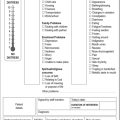11 Caring for the patient undergoing haemopoietic stem cell transplant
Introduction
Patients with a haematological malignancy such as leukaemia, lymphoma and myeloma may undergo a haemopoietic stem cell transplant as part of their cancer treatment. This is a highly specialised procedure and is undertaken in a specialised transplant unit. If you have been allocated to a specialist transplant unit, you will have the opportunity to observe and experience high-intensity transplants and learn to care for acutely sick patients. If you have not been allocated to this area, you may be able to arrange an insight visit. Whether you get the opportunity to visit a haemopoietic transplant unit or not, you may meet individuals who are either preparing for the procedure or who have undergone the treatment. Increasingly, low-risk haemopoietic stem cell transplants are being performed in more general areas such as the community setting (Dix & Geller 2000). This requires community-based healthcare professionals to be knowledgeable and skilled in caring for these patients. Although the transplant phase is very intensive and patients can become critically unwell, patients require long-term support so you may meet these patients during the post-transplant phase.
There are three types of haemopoietic transplant, depending on where the stems cells come from:
• Autologous transplant: this involves taking stems cells from the patient and then processing and freezing them. The patient then receives high-dose cytotoxic therapy ± radiotherapy and this gets rid of the cancer cells. The frozen cells are defrosted and infused (like a blood transfusion) to repopulate the patient’s bone marrow.
• Syngeneic transplant: this uses an identical twin’s stem cells. This is essentially like an autologous transplant, but has a better chance of success.
• Allogeneic transplant: this uses stem cells from a donor (this may be a family member or a stranger on a national database) who has a similar tissue type. Either stem cells are removed from the peripheral blood, or umbilical cord blood may be used. When a baby is born, a mother can decide whether to have the umbilical cord blood frozen. This can be kept in case the child or a sibling requires a haemopoietic stem cell transplant in later life. Alternatively, it may be donated to the national database to be donated for an allogeneic transplant or it may be destroyed.
Side effects
The procedure is often associated with significant mortality and the physical and psychosocial status of patients is commonly disrupted and their recovery slow, affecting quality of life (Liptrott 2007).
It usually takes a few weeks before it is known whether the transplant has been successful. If donor cells are used, there is a chance that the patient may reject the new stems cells. This is known as graft versus host disease (GVHD) and can cause debilitating side effects such as skin blistering, reduced liver function and gastrointestinal tract disturbance. There may be many severe long-term side effects of GVHD such as infertility, cataracts, reduced hormone production, pulmonary complications and relapse (Brown 2010). To minimise GVHD, immunosuppressive therapy is used, such as ciclosporin (given orally), which may be continued for months or years if the patient experiences chronic GVDH (Grundy 2006).
Brown M. Nursing care of patients undergoing allogeneic stem cell transplantation. Nursing Standard. 2010;25(11):47–56.
Dix S., Geller R. High dose chemotherapy with autologous stem cell rescue in the outpatient setting. Oncology. 2000;14(2):171–186.
Grundy M. Nursing in haematological oncology, 2nd ed. Edinburgh: Baillière Tindall; 2006.
Liptrott S. Quality of life in stem cell transplant patients; a literature review. Cancer Nursing Practice. 2007;6(10):29–33.
Ritchie L. Outpatient stem cell transplant: effectiveness and implications. British Journal of Community Nursing. 2005;10(1):14.
American Cancer Society, http://www.cancer.org/Treatment/TreatmentsandSideEffects/TreatmentTypes/BoneMarrowandPeripheralBloodStemCellTransplant/index (accessed May 2011).
Leukaemia Society, http://www.leukaemiasociety.org/ (accessed May 2011).
Lymphoma Association, http://www.lymphomas.org.uk/info/treatments.asp (accessed May 2011).
Macmillan information for patients, http://www.macmillan.org.uk/Cancerinformation/Cancertreatment/Treatmenttypes/Stemcellbonemarrowtransplants/Highdosetreatment/Highdosetreatment.aspx (accessed May 2011).
Myeloma Association, http://www.myeloma.org.uk/ (accessed May 2011).


